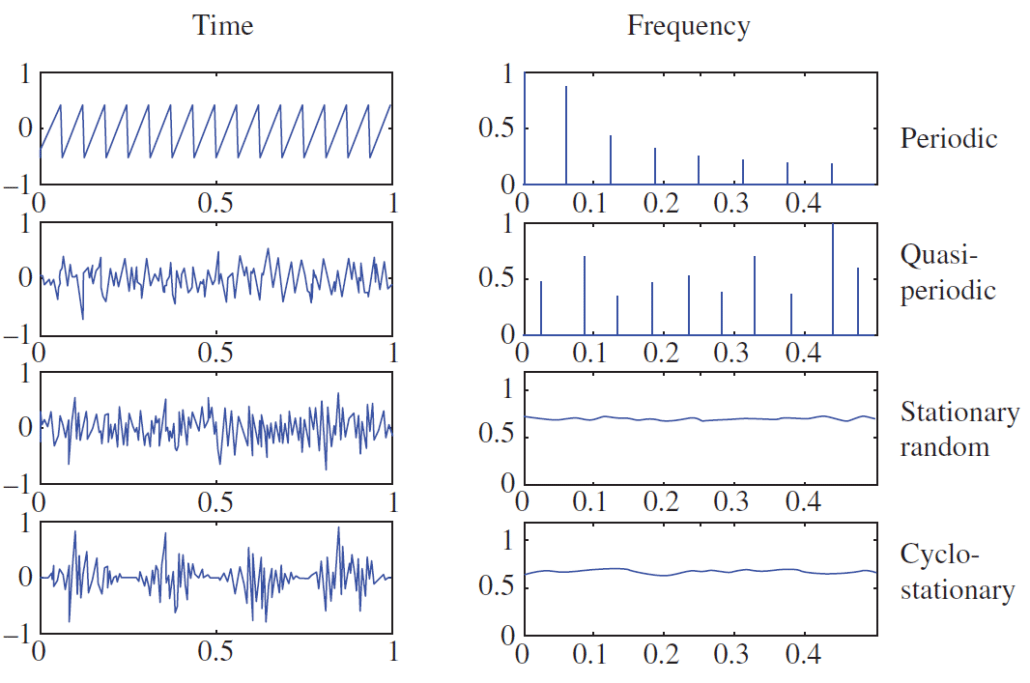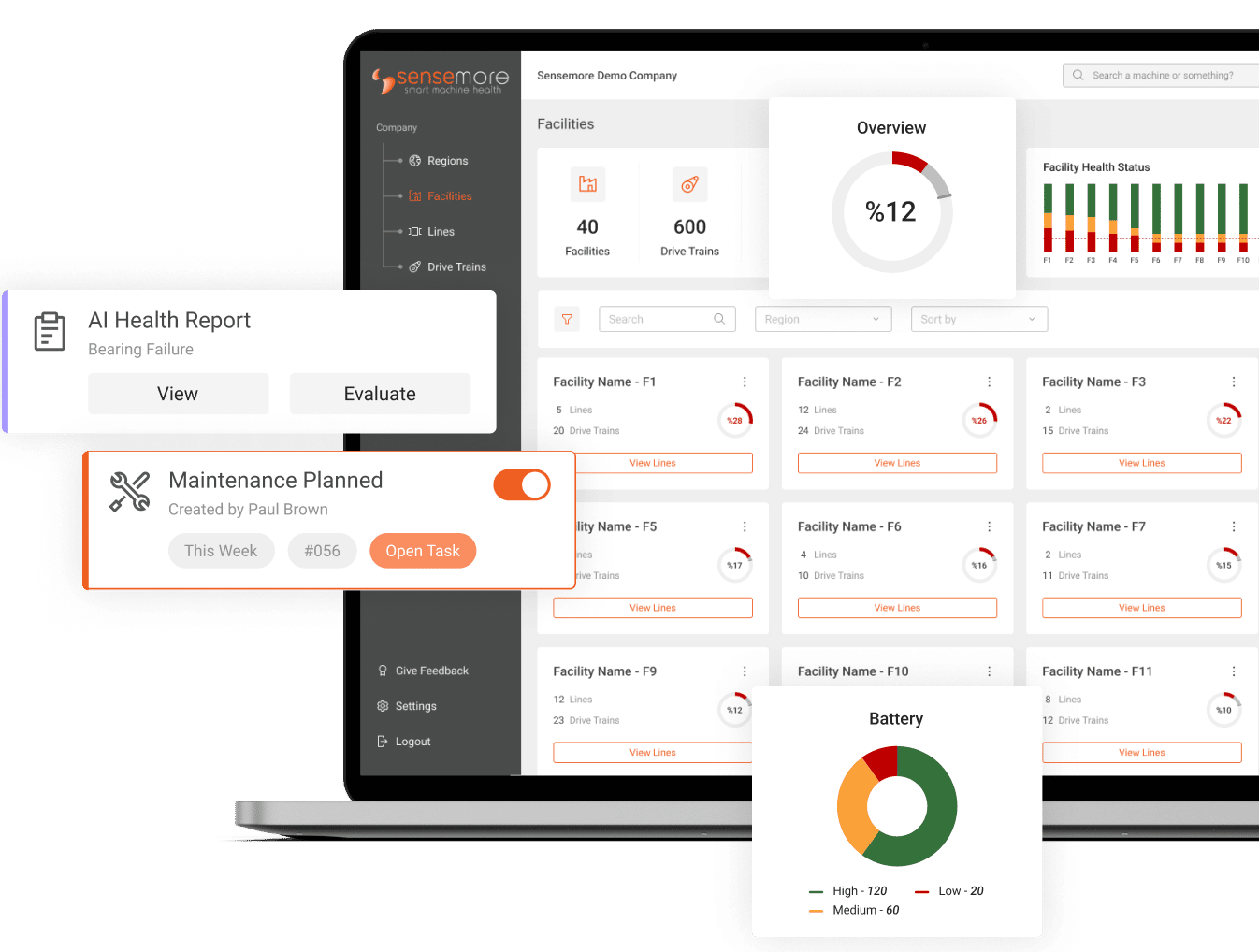Machinery data encompasses the extensive set of information generated by rotating machinery during its operational cycles. This data comprises various measurable parameters, performance metrics, and operational characteristics, providing a comprehensive digital representation of the machinery’s behavior.
In the contemporary landscape of the Internet of Things (IoT) and Big Data management, machine data holds importance. It serves as the lifeblood for informed decision-making, facilitating predictive maintenance, optimizing operational efficiency, and contributing to overarching system enhancements.
Overview of Sensors, Software, and Machine Manufacturers’ Contribution
The acquisition and utilization of machinery data are made possible through a synergy of advanced sensors, sophisticated software, and the proactive contribution of machine manufacturers. Sensors, ranging from vibration sensors to temperature gauges, act as data collectors. Software applications, in turn, process this raw data to extract meaningful insights. Additionally, machine manufacturers play a pivotal role by integrating state-of-the-art sensors and data interfaces into their machinery, fostering seamless data flow and enhancing overall system intelligence. This collaborative effort ensures a holistic approach to leveraging machine data for improved performance and maintenance strategies.
Types of Machinery Data
Quantitative Data
Quantitative data within the realm of rotating machinery pertains to measurable parameters and numerical values that provide a quantitative assessment of the machine’s performance. These may include metrics such as temperature, pressure, speed, and vibration levels.
Role in Predictive Maintenance Applications
Quantitative data plays a pivotal role in predictive maintenance strategies. By continuously monitoring and analyzing quantitative metrics, anomalies and potential issues can be identified early, enabling proactive maintenance measures and minimizing downtime.
Signal Processing Techniques
Stationary vs. Non-Stationary Signals
In signal processing, machinery data is categorized into stationary and non-stationary signals. Stationary signals have constant statistical properties over time, while non-stationary signals exhibit variations in their statistical properties.
Deterministic vs. Random Signals
Signals can be deterministic, following a predictable pattern, or random, lacking a discernible pattern. Understanding these signal characteristics is crucial for accurate data interpretation.
Categorization of Vibration Signals
Vibration signals are categorized based on overall values, providing a comprehensive view of machine health.
Statistical Data Extraction
Statistical methods extract valuable information from vibration signals, aiding in the identification of patterns indicative of potential faults.
Signal Types for Predictive Maintenance
Various signal types, such as frequency and time-domain signals, are employed in predictive maintenance to detect and diagnose machinery issues before they escalate.
Signal Categorization Case Study
Vibration, which is one of the most important data used in the condition analysis of rotating machines, can be collected in 2 different types. Vibration sensors used in PLC-SCADA systems are generally overall value vibration sensors. These sensors use certain features such as RMS, Crest, Kurtosis, which it extracts from the vibration signal collected with fixed sampling frequencies at a certain time. These features are actually another data extracted from the measured data. On the other hand, the sampled signals can be analyzed in time-wave form at certain interfaces and the processed signals in different spaces such as spectrum and cepstrum.
Different statistical data can be obtained from a collected signal data, as well as data which is also called “data about data” calculated from 2 different data. These data can be the extraction of power data from current and voltage values, as well as the phase difference from two different vibration data or the stiffness/damping properties of the structure from force and vibration data. At the same time, coherence, correlation and covariance data, which includes statistical comparison results of 2 different data, can also be examined under quantitative data.
The collected signal data is also divided into different groups within itself. Most machine components give rise to certain vibration signals that characterize their separation from others, as well as distinguishing the faulty state from the healthy state. Distinctive features may be different repetition frequencies. For example; there may be a gear network frequency characterizing a particular gear pair, and different sideband gaps characterizing the modulating effects of two meshing gears on their common network frequencies. Vibration signals collected for predictive maintenance can be categorized in several ways. The type of signal obtained also affects the signal processing technique that should be applied. We can categorize vibration signals as in the image below.

Fig. 1 Signal Categorization
The most basic distinction in signals is stationary and non-stationary. Stationarity means that statistical properties are time-invariant. Deterministic signals basically mean that they are composed entirely of discrete frequencies of self-forming sinusoids. Knowing the frequency, amplitude and initial phase (ie at time zero) of these components, the value of the signal can be estimated at any time in the future or in the past; hence it is “deterministic”. Random signals are somewhat more complex as their values cannot be predicted at any time, but for stationary random signals their statistical properties do not change over time.
“Non-stationary” means anything that does not satisfy the stationary conditions and can be divided into two main classes, “continuously changing” and “temporary”. There is no hard rule to distinguish these two types, but in general it can be said that transient signals only exist for a limited period of time and are typically analyzed as presence only during that time. To explain this; for example, a decreasing exponential function theoretically decreases to infinity, but in practical terms it has measurable value only for a finite time.
By definition, a stationary random signal has a constant power and thus infinite energy. Cylostationary signals, by definition, have power that varies periodically over time, and hence their total energy is infinite. Other non-stationary signals, such as vibration signals measured during operation or deceleration of a machine, also have a finite length, but are typically more likely to be considered as constantly changing non-stationary signals rather than transient events. Continuously changing non-stationary signals are usually analyzed by time/frequency analysis techniques.

Fig. 2 Sample Signal Types
Qualitative Data (Metadata)
Qualitative data, or metadata, includes non-numeric information that adds context to quantitative measurements. It provides insights into the circumstances surrounding machine operation.
Examples of Metadata in Predictive Maintenance
Metadata in predictive maintenance may include operational conditions, environmental factors, and maintenance history. These contextual details enhance the understanding of quantitative data.
Correlation with Quantitative Data for Fault Root-Cause Diagnosis
The correlation of qualitative metadata with quantitative data is crucial for identifying the root causes of faults. By combining both types of data, a comprehensive picture emerges, aiding in accurate diagnosis and effective maintenance decision-making.

Reliability Engineer’s Role
Role in Processing Raw Machine-Generated Data
Reliability engineers play a crucial role in processing raw machine-generated data, acting as the bridge between the influx of data and actionable insights. They are responsible for collecting, organizing, and interpreting the raw data streams, ensuring its readiness for further analysis and decision-making.
Utilization of Predictive Maintenance Platforms
Reliability engineers leverage predictive maintenance platforms to streamline and enhance their data analysis efforts. These platforms integrate advanced algorithms and machine learning models to identify patterns, anomalies, and potential failure points within the machinery data. By harnessing these platforms, reliability engineers can implement proactive maintenance strategies.
Contextualizing Data for Knowledge Generation
Addressing Questions: Where, What, When
Reliability engineers contextualize data by addressing key questions related to the machine’s operation. This involves determining where anomalies occur, what specific parameters are affected, and when these issues manifest. Such contextualization lays the foundation for targeted analysis.
Transformation of Data into Knowledge
The transformation of raw data into knowledge is a multi-faceted process. Reliability engineers apply statistical methods, machine learning algorithms, and domain expertise to distill meaningful insights from the data. This transformation is integral to making informed decisions regarding maintenance and system optimization.
Goal: Concrete Determinations and Predictions for System Improvement
The ultimate goal of reliability engineers is to derive concrete determinations and predictions from the processed data. By identifying potential points of failure, predicting maintenance needs, and understanding system vulnerabilities, reliability engineers contribute to continuous improvement initiatives. Their insights guide decision-makers in implementing targeted interventions to enhance overall system reliability and efficiency.
Rotating Machinery Data Analytics Tools
Application of DIKW Pyramid
Data Collection
At the base of the Data-Information-Knowledge-Wisdom (DIKW) Pyramid lies data collection. Machine data analytics tools are equipped with robust mechanisms for efficiently gathering raw data from various sensors and sources, ensuring a comprehensive dataset for subsequent analysis.
AI Algorithms for Trend Identification
Ascending the pyramid, machine data analytics tools employ advanced artificial intelligence (AI) algorithms to identify trends within the collected data. These algorithms sift through vast datasets, recognizing patterns, anomalies, and potential correlations that may escape manual analysis.
Extensive Analysis and Correlation
Moving towards the knowledge layer, these tools conduct extensive analysis and correlation of the identified trends. They go beyond surface-level observations, delving into the interconnections between different variables. This in-depth analysis enhances the understanding of the underlying processes and relationships within the machine data.
Generation of New Knowledge and Insights
At the knowledge pinnacle, machine data analytics tools generate new knowledge and insights. By synthesizing the outcomes of data analysis, these tools provide a holistic understanding of the machinery’s performance, potential risks, and optimization opportunities. This knowledge forms the basis for informed decision-making.
Reporting and Action
Communicating Insights to Users
Machine data analytics tools facilitate the communication of insights to users through comprehensive reporting mechanisms. Clear and concise reports, often visualized through graphs and charts, convey the derived knowledge. This ensures that stakeholders, including reliability engineers and decision-makers, can easily interpret and act upon the findings.
Taking Action to Improve System State
The ultimate objective is to move from insights to action. Machine data analytics tools empower users to take proactive measures to improve the system state. Whether it involves scheduling maintenance, adjusting operational parameters, or implementing system enhancements, the actionable intelligence derived from these tools guides effective interventions for optimizing machinery performance and reliability.
References:
- Randall, R. B. (2022). Vibration-based condition monitoring: Industrial, automotive and Aerospace Applications. Wiley.
Recommended Blog Posts
September 4, 2023
Powerful Signal Analysis Tools for Vibration Analysis
Predictive maintenance, crucial for machinery reliability, heavily relies on vibration analysis. Techniques like FFT…
September 4, 2023
Rotating Machinery Vibration Analysis
Vibration analysis is a critical tool in various industries like manufacturing, power generation, and transportation.…
December 28, 2022
Fault Diagnostic Technique Using Machine Mode Similarity Analysis
AI can diagnose machine faults with vibration data but machine mode similarity analysis is an alternative, it uses…
August 6, 2021
Envelope Analysis
Bearings are critical elements in rotating machines, they support radial and axial loads, and reduce friction. Real…
May 6, 2021
What is Cepstral Analysis?
Cepstral Analysis, a tool used to detect periodicity in frequency spectrum, can be useful in gearbox fault detection in…
October 9, 2020
How is Fault Detection Performed?
Vibration measurements and analysis, using multiple parameters, can identify developing problems in machinery before…
September 21, 2020
Parameter Selections in Vibration Measurement
Vibration measurements are used to determine the response of machines to forces and identify potential issues. It is…
September 4, 2020
What is Vibration Analysis?
Vibration analysis can be used to discover problems in machines and predict when they might fail. It can significantly…











